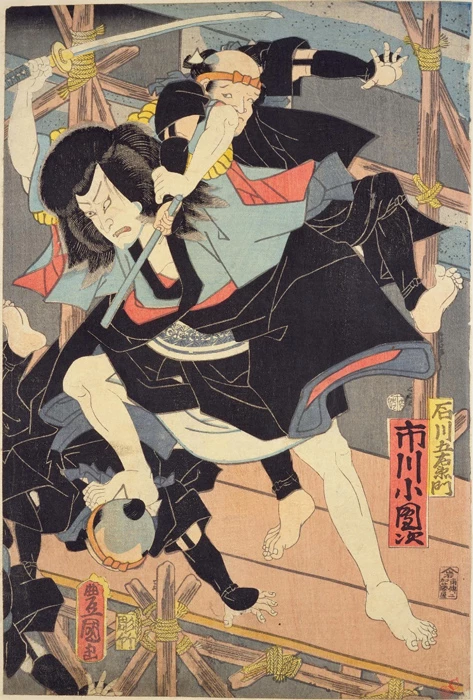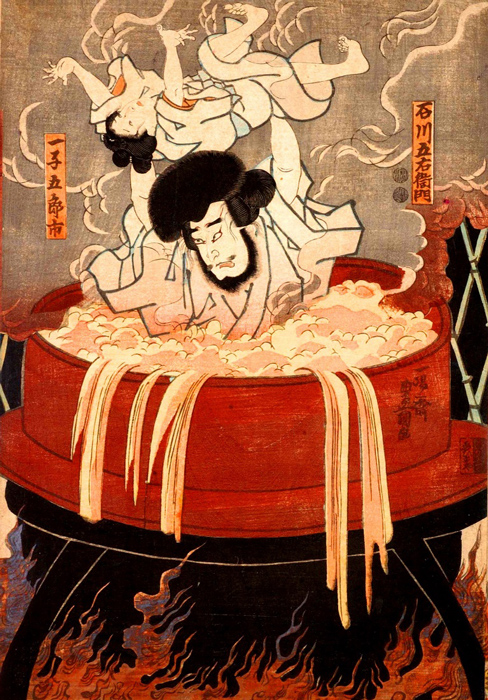Everyone knows the story of Robin Hood. The English outlaw who robbed from the rich and gave to the poor is the stuff of legend, even if we cannot be certain whether any of it is true.
But in the legends of far-off Japan there is another outlaw known as Ishikawa Goemon, who is seen as Japan’s own Robin Hood. As with the English story, much about this man is uncertain, and even his place of birth is not known for sure.
It is said that he was born in Iga, a poor province near the city of Kyoto. Orphaned at an early age, he was raised by his adopted parents and trained to be a ninja.
Fleeing from Iga after being discovered in an affair with one of his master’s mistresses, he relocated west to Kansai, where he formed a group of thieves and targeted the rich noblemen of the region. He distributed this looted wealth among the poor to help them, becoming a local hero and the subject of many legendary tales.
Although the legends of Goemon are in fragments, there is evidence to show that Goemon did exist. In the biography of the samurai warlord Toyotomi Hideyoshi, for example there is mention of him where he is referred to as a thief.
Were the stories about Ishikawa Goemon true? Did he even exist at all?
A Famous Character
There are in fact several different accounts of Goemon’s life. For example, one historical account claims that he was born as Sanada Kuranoshin in 1558 in a Samurai clan that served the Miyoshi clan of Iga province. Another has him as a man called Gorokizu from Kawachi, another nearby province.
As a child, it was believed that Sanada saw his father and mother killed by soldiers of the Ashikaga Shogunate, the oppressive military rulers of Japan. Sanada swore revenge for the death of his father.
- England’s Great Outlaw, Robin Hood: Real or Legend?
- Indrid Cold: Grinning Man of 1960s American Folklore
It is believed that the fifteen-year-old Samurai trained under Momochi Sandayu, the founder of the ninjutsu school in the Iga province. Though orphaned, Sanada was brought up as his master’s son who continued with his rigorous training.

However, the tables would turn when Sanada would be drawn to his master’s wife and later be banished from the household when this was discovered. In different versions of the story, he would also steal his master’s legendary sword or even his master’s wife, although in all versions his lover is killed.
Some stories have Goemon murder the woman, claiming that she was only slowing him down. This portrayal of Goemon as a short-tempered and impatient man is in contrast with his later depiction as a charitable thief who robbed the rich for a noble cause.
In the other, Kawachi origin story, he is not portrayed as a runaway thief. In the story, he moves to the Kansai region and forms a band of thieves who rob the wealthy to distribute this wealth among poor people.
He would rob the rich at night with the help of his thief friends. In the daylight, they would pose as merchants, trying to establish social connections and discover who was worth robbing.
Goemon and his thieves would then scatter their loot among many people to throw off authorities from the thievery. This offers a starkly different motive to that of Robin Hood, and raises the question of whether he wanted to help the poor or he used the public as an excuse to cloak his rampant thievery.
Only in the later Edo period of Japanese history that he was made into a public hero. It is unclear if he was actually the hero he was portrayed as or just a thief who liked to do occasional acts of charity, with the poor benefitting more through chance than anything else.
A Tragic Death
What sealed Goemon’s image as a legend was the manner of his death, one so tragic and heroic that he was remembered for all time. After the warlord Hideyoshi had killed Goemon’s wife and son, Goemon swore revenge.
- Land of the Rising Sun: Did Jesus Retire To Rural Japan?
- Lepa Radić, Teenage Hero Of Yugoslavian Resistance
Slipping into Hideyoshi’s castle at Fushimi, he entered the warlord’s room and was about to strike when he knocked a bell off the table, alerting the guards. Captured and finally unmasked as a thief and would-be assassin, Goemon was brought to the main gate of the Buddhist temple at Nanzen-Ji in Kyoto.
In another account of his capture and death, it is said that Hideyoshi was alerted of Goemon’s presence in the castle by a magical incense burner. He was captured and sentenced to death.
Goemon however was not beheaded, as was the tradition at that time. A far more gruesome death was in store: he was ordered to be put into a cauldron with his son and boiled to death.

And so it was. He was indeed put into a cauldron, but he tried to saved his young son by holding him above his head while he was in pain. In some stories his son was saved by the onlookers and forgiven. In others, realizing the futility of saving his son, Goemon threw him down into the boiling liquid to ensure his death was as swift as possible.
Then, he held the dead body of his son over his head as a mark of defiance against Hideyoshi. He died unrepentant and in defiance of what he saw a tyranny.
Before his death, he admitted to being a thief. However, he also called Hideyoshi a thief who had stolen Japan from its people. This refusal to give in to the warlord ensured his place in Japanese folklore.
An Exaggerated Truth?
As mentioned, the biography of Hideyoshi is seen as a reasonably reliable source and confirms the existence of the man Goemon, and the manner of his death. His origin and the redistribution of the wealth he stole are less certain.
Before his death, Goemon wrote a poem about how no matter how the world turns out to be, there will always be thieves here. Whether Goemon was a hero or a common thief, he remains glorified in the folklore and legends of Japan.
Top Image: How many of the stories of Ishikawa Goemon are real? Source: Grandfailure / Adobe Stock.
By Bipin Dimri